Comparative Analysis of Ecological Footprints: India and Australia
VerifiedAdded on 2020/12/09
|9
|2493
|343
Report
AI Summary
This report provides an in-depth analysis of ecological footprints, focusing on a comparative study between India and Australia. It begins by defining ecological footprints and their significance in measuring environmental impact, including the consumption of natural resources, land use, and carbon emissions. The report then outlines the methodology for calculating ecological footprints, using national footprint accounts and considering factors like bio-capacity and resource consumption. A key aspect of the report involves comparing the ecological footprints of India and Australia, examining their respective human development indices, ecological deficits or reserves, and sustainable development practices. The analysis explores various aspects of resource consumption in both countries, including food, housing, transportation, and energy usage. The report highlights differences in resource management, environmental impact, and sustainability between the two nations, providing insights into their ecological footprints and implications for sustainable development. The report concludes by emphasizing the importance of ecological footprints as a tool for understanding resource utilization and promoting sustainable practices, aiming to inform strategies for reducing environmental impact and achieving ecological balance.

ECOLOGICAL FOOTPRINT
Paraphrase This Document
Need a fresh take? Get an instant paraphrase of this document with our AI Paraphraser

Table of Contents
Topic : Ecological footprints ..........................................................................................................3
REFERENCES ...............................................................................................................................9
Topic : Ecological footprints ..........................................................................................................3
REFERENCES ...............................................................................................................................9
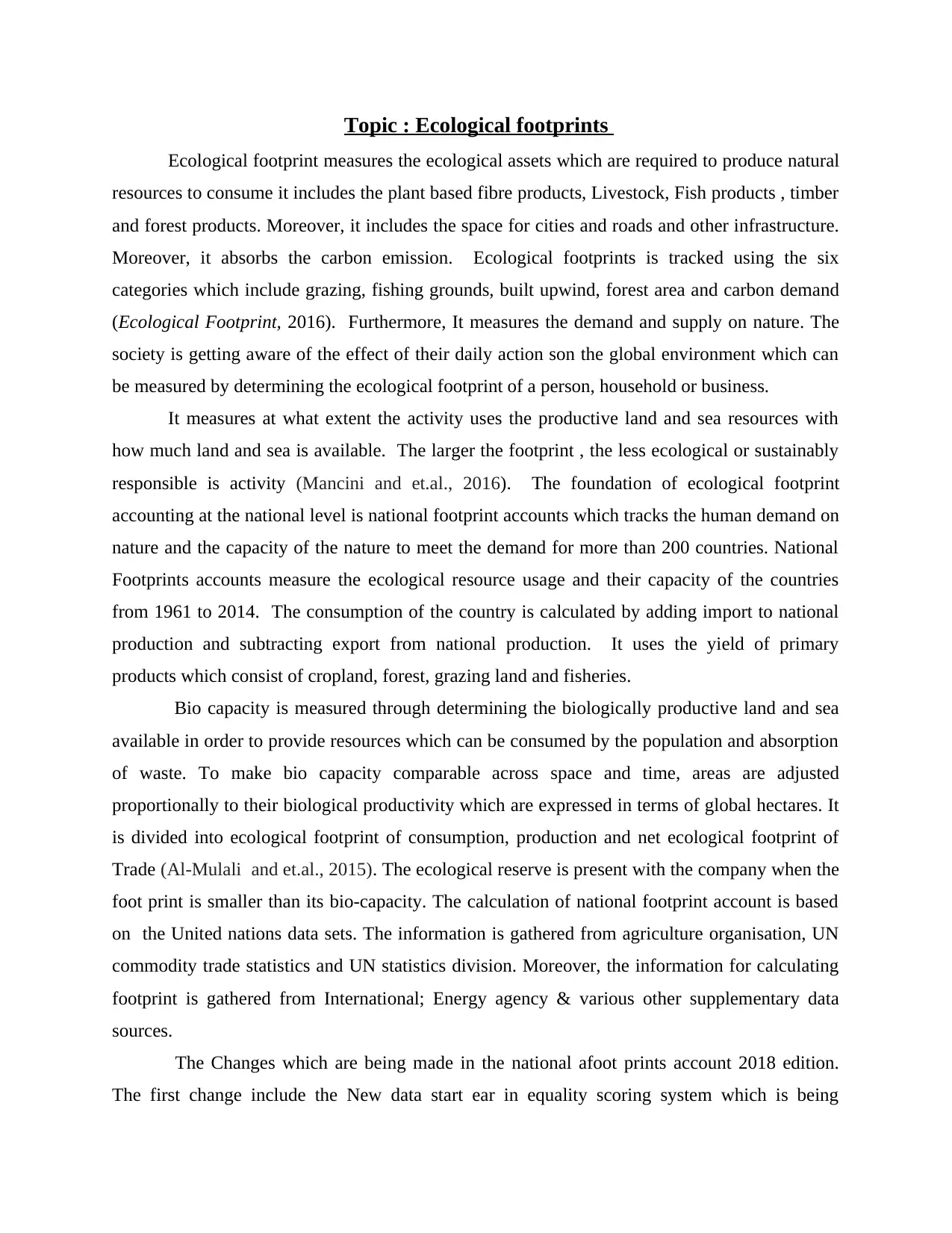
Topic : Ecological footprints
Ecological footprint measures the ecological assets which are required to produce natural
resources to consume it includes the plant based fibre products, Livestock, Fish products , timber
and forest products. Moreover, it includes the space for cities and roads and other infrastructure.
Moreover, it absorbs the carbon emission. Ecological footprints is tracked using the six
categories which include grazing, fishing grounds, built upwind, forest area and carbon demand
(Ecological Footprint, 2016). Furthermore, It measures the demand and supply on nature. The
society is getting aware of the effect of their daily action son the global environment which can
be measured by determining the ecological footprint of a person, household or business.
It measures at what extent the activity uses the productive land and sea resources with
how much land and sea is available. The larger the footprint , the less ecological or sustainably
responsible is activity (Mancini and et.al., 2016). The foundation of ecological footprint
accounting at the national level is national footprint accounts which tracks the human demand on
nature and the capacity of the nature to meet the demand for more than 200 countries. National
Footprints accounts measure the ecological resource usage and their capacity of the countries
from 1961 to 2014. The consumption of the country is calculated by adding import to national
production and subtracting export from national production. It uses the yield of primary
products which consist of cropland, forest, grazing land and fisheries.
Bio capacity is measured through determining the biologically productive land and sea
available in order to provide resources which can be consumed by the population and absorption
of waste. To make bio capacity comparable across space and time, areas are adjusted
proportionally to their biological productivity which are expressed in terms of global hectares. It
is divided into ecological footprint of consumption, production and net ecological footprint of
Trade (Al-Mulali and et.al., 2015). The ecological reserve is present with the company when the
foot print is smaller than its bio-capacity. The calculation of national footprint account is based
on the United nations data sets. The information is gathered from agriculture organisation, UN
commodity trade statistics and UN statistics division. Moreover, the information for calculating
footprint is gathered from International; Energy agency & various other supplementary data
sources.
The Changes which are being made in the national afoot prints account 2018 edition.
The first change include the New data start ear in equality scoring system which is being
Ecological footprint measures the ecological assets which are required to produce natural
resources to consume it includes the plant based fibre products, Livestock, Fish products , timber
and forest products. Moreover, it includes the space for cities and roads and other infrastructure.
Moreover, it absorbs the carbon emission. Ecological footprints is tracked using the six
categories which include grazing, fishing grounds, built upwind, forest area and carbon demand
(Ecological Footprint, 2016). Furthermore, It measures the demand and supply on nature. The
society is getting aware of the effect of their daily action son the global environment which can
be measured by determining the ecological footprint of a person, household or business.
It measures at what extent the activity uses the productive land and sea resources with
how much land and sea is available. The larger the footprint , the less ecological or sustainably
responsible is activity (Mancini and et.al., 2016). The foundation of ecological footprint
accounting at the national level is national footprint accounts which tracks the human demand on
nature and the capacity of the nature to meet the demand for more than 200 countries. National
Footprints accounts measure the ecological resource usage and their capacity of the countries
from 1961 to 2014. The consumption of the country is calculated by adding import to national
production and subtracting export from national production. It uses the yield of primary
products which consist of cropland, forest, grazing land and fisheries.
Bio capacity is measured through determining the biologically productive land and sea
available in order to provide resources which can be consumed by the population and absorption
of waste. To make bio capacity comparable across space and time, areas are adjusted
proportionally to their biological productivity which are expressed in terms of global hectares. It
is divided into ecological footprint of consumption, production and net ecological footprint of
Trade (Al-Mulali and et.al., 2015). The ecological reserve is present with the company when the
foot print is smaller than its bio-capacity. The calculation of national footprint account is based
on the United nations data sets. The information is gathered from agriculture organisation, UN
commodity trade statistics and UN statistics division. Moreover, the information for calculating
footprint is gathered from International; Energy agency & various other supplementary data
sources.
The Changes which are being made in the national afoot prints account 2018 edition.
The first change include the New data start ear in equality scoring system which is being
⊘ This is a preview!⊘
Do you want full access?
Subscribe today to unlock all pages.

Trusted by 1+ million students worldwide
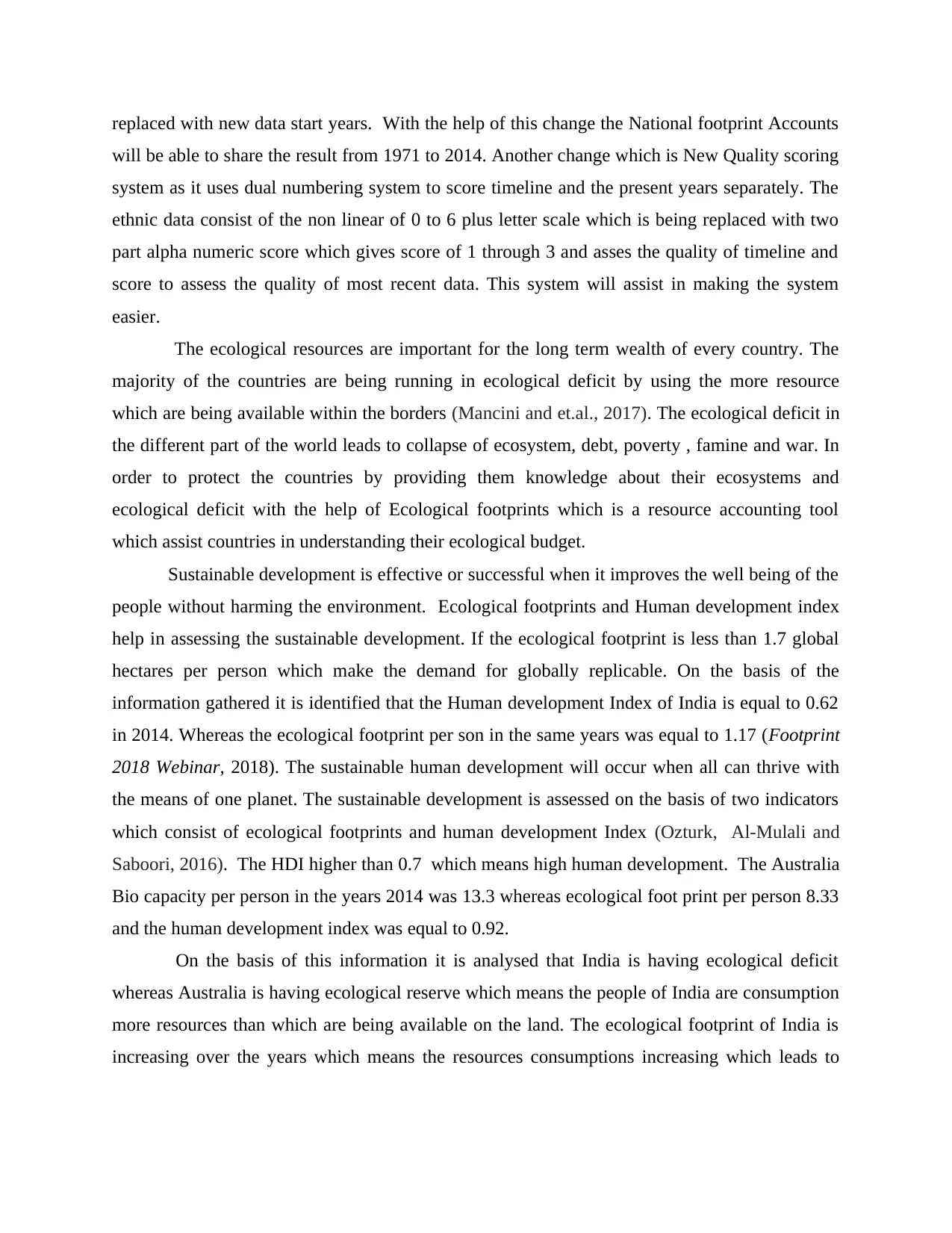
replaced with new data start years. With the help of this change the National footprint Accounts
will be able to share the result from 1971 to 2014. Another change which is New Quality scoring
system as it uses dual numbering system to score timeline and the present years separately. The
ethnic data consist of the non linear of 0 to 6 plus letter scale which is being replaced with two
part alpha numeric score which gives score of 1 through 3 and asses the quality of timeline and
score to assess the quality of most recent data. This system will assist in making the system
easier.
The ecological resources are important for the long term wealth of every country. The
majority of the countries are being running in ecological deficit by using the more resource
which are being available within the borders (Mancini and et.al., 2017). The ecological deficit in
the different part of the world leads to collapse of ecosystem, debt, poverty , famine and war. In
order to protect the countries by providing them knowledge about their ecosystems and
ecological deficit with the help of Ecological footprints which is a resource accounting tool
which assist countries in understanding their ecological budget.
Sustainable development is effective or successful when it improves the well being of the
people without harming the environment. Ecological footprints and Human development index
help in assessing the sustainable development. If the ecological footprint is less than 1.7 global
hectares per person which make the demand for globally replicable. On the basis of the
information gathered it is identified that the Human development Index of India is equal to 0.62
in 2014. Whereas the ecological footprint per son in the same years was equal to 1.17 (Footprint
2018 Webinar, 2018). The sustainable human development will occur when all can thrive with
the means of one planet. The sustainable development is assessed on the basis of two indicators
which consist of ecological footprints and human development Index (Ozturk, Al-Mulali and
Saboori, 2016). The HDI higher than 0.7 which means high human development. The Australia
Bio capacity per person in the years 2014 was 13.3 whereas ecological foot print per person 8.33
and the human development index was equal to 0.92.
On the basis of this information it is analysed that India is having ecological deficit
whereas Australia is having ecological reserve which means the people of India are consumption
more resources than which are being available on the land. The ecological footprint of India is
increasing over the years which means the resources consumptions increasing which leads to
will be able to share the result from 1971 to 2014. Another change which is New Quality scoring
system as it uses dual numbering system to score timeline and the present years separately. The
ethnic data consist of the non linear of 0 to 6 plus letter scale which is being replaced with two
part alpha numeric score which gives score of 1 through 3 and asses the quality of timeline and
score to assess the quality of most recent data. This system will assist in making the system
easier.
The ecological resources are important for the long term wealth of every country. The
majority of the countries are being running in ecological deficit by using the more resource
which are being available within the borders (Mancini and et.al., 2017). The ecological deficit in
the different part of the world leads to collapse of ecosystem, debt, poverty , famine and war. In
order to protect the countries by providing them knowledge about their ecosystems and
ecological deficit with the help of Ecological footprints which is a resource accounting tool
which assist countries in understanding their ecological budget.
Sustainable development is effective or successful when it improves the well being of the
people without harming the environment. Ecological footprints and Human development index
help in assessing the sustainable development. If the ecological footprint is less than 1.7 global
hectares per person which make the demand for globally replicable. On the basis of the
information gathered it is identified that the Human development Index of India is equal to 0.62
in 2014. Whereas the ecological footprint per son in the same years was equal to 1.17 (Footprint
2018 Webinar, 2018). The sustainable human development will occur when all can thrive with
the means of one planet. The sustainable development is assessed on the basis of two indicators
which consist of ecological footprints and human development Index (Ozturk, Al-Mulali and
Saboori, 2016). The HDI higher than 0.7 which means high human development. The Australia
Bio capacity per person in the years 2014 was 13.3 whereas ecological foot print per person 8.33
and the human development index was equal to 0.92.
On the basis of this information it is analysed that India is having ecological deficit
whereas Australia is having ecological reserve which means the people of India are consumption
more resources than which are being available on the land. The ecological footprint of India is
increasing over the years which means the resources consumptions increasing which leads to
Paraphrase This Document
Need a fresh take? Get an instant paraphrase of this document with our AI Paraphraser
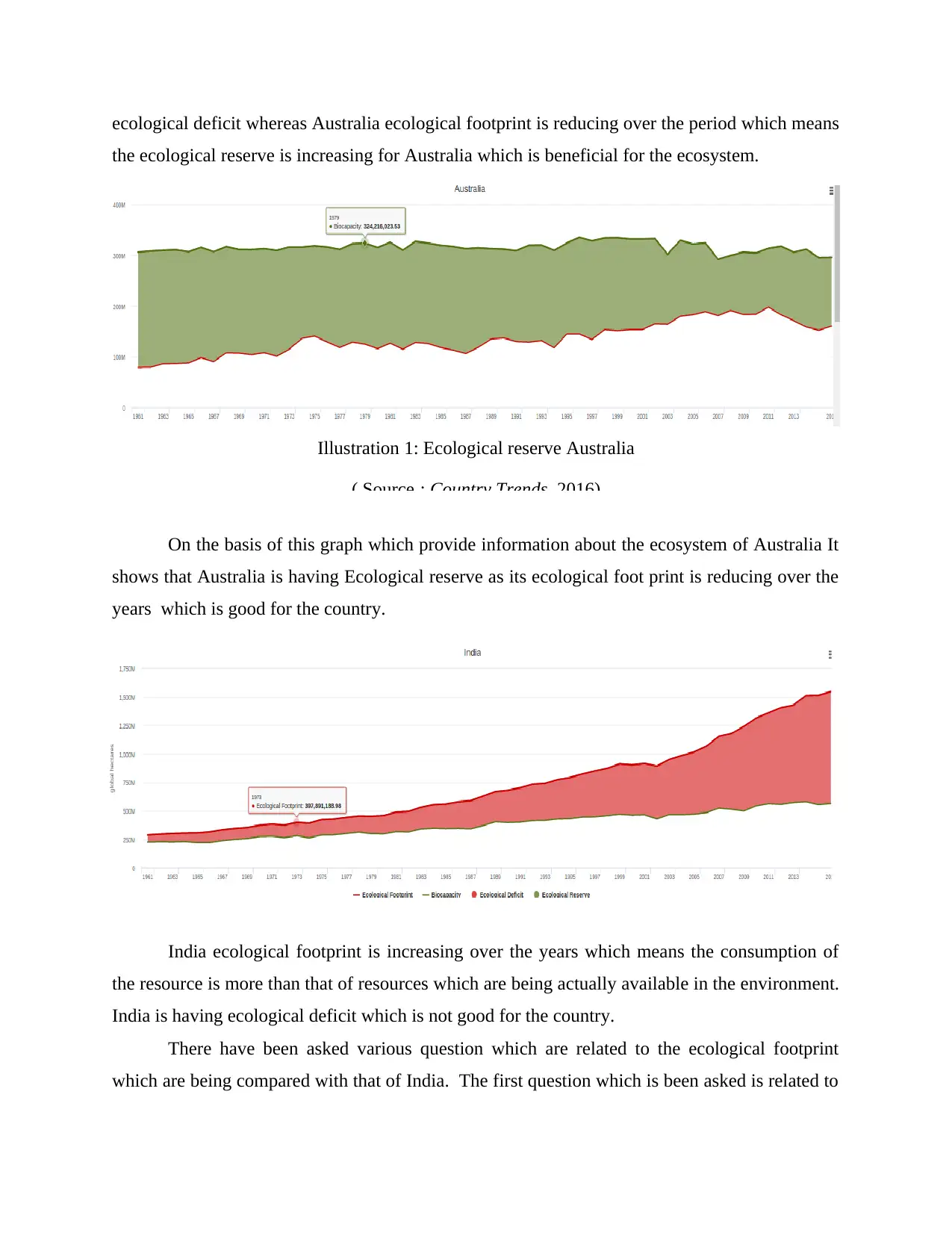
ecological deficit whereas Australia ecological footprint is reducing over the period which means
the ecological reserve is increasing for Australia which is beneficial for the ecosystem.
On the basis of this graph which provide information about the ecosystem of Australia It
shows that Australia is having Ecological reserve as its ecological foot print is reducing over the
years which is good for the country.
India ecological footprint is increasing over the years which means the consumption of
the resource is more than that of resources which are being actually available in the environment.
India is having ecological deficit which is not good for the country.
There have been asked various question which are related to the ecological footprint
which are being compared with that of India. The first question which is been asked is related to
Illustration 1: Ecological reserve Australia
( Source : Country Trends, 2016)
the ecological reserve is increasing for Australia which is beneficial for the ecosystem.
On the basis of this graph which provide information about the ecosystem of Australia It
shows that Australia is having Ecological reserve as its ecological foot print is reducing over the
years which is good for the country.
India ecological footprint is increasing over the years which means the consumption of
the resource is more than that of resources which are being actually available in the environment.
India is having ecological deficit which is not good for the country.
There have been asked various question which are related to the ecological footprint
which are being compared with that of India. The first question which is been asked is related to
Illustration 1: Ecological reserve Australia
( Source : Country Trends, 2016)
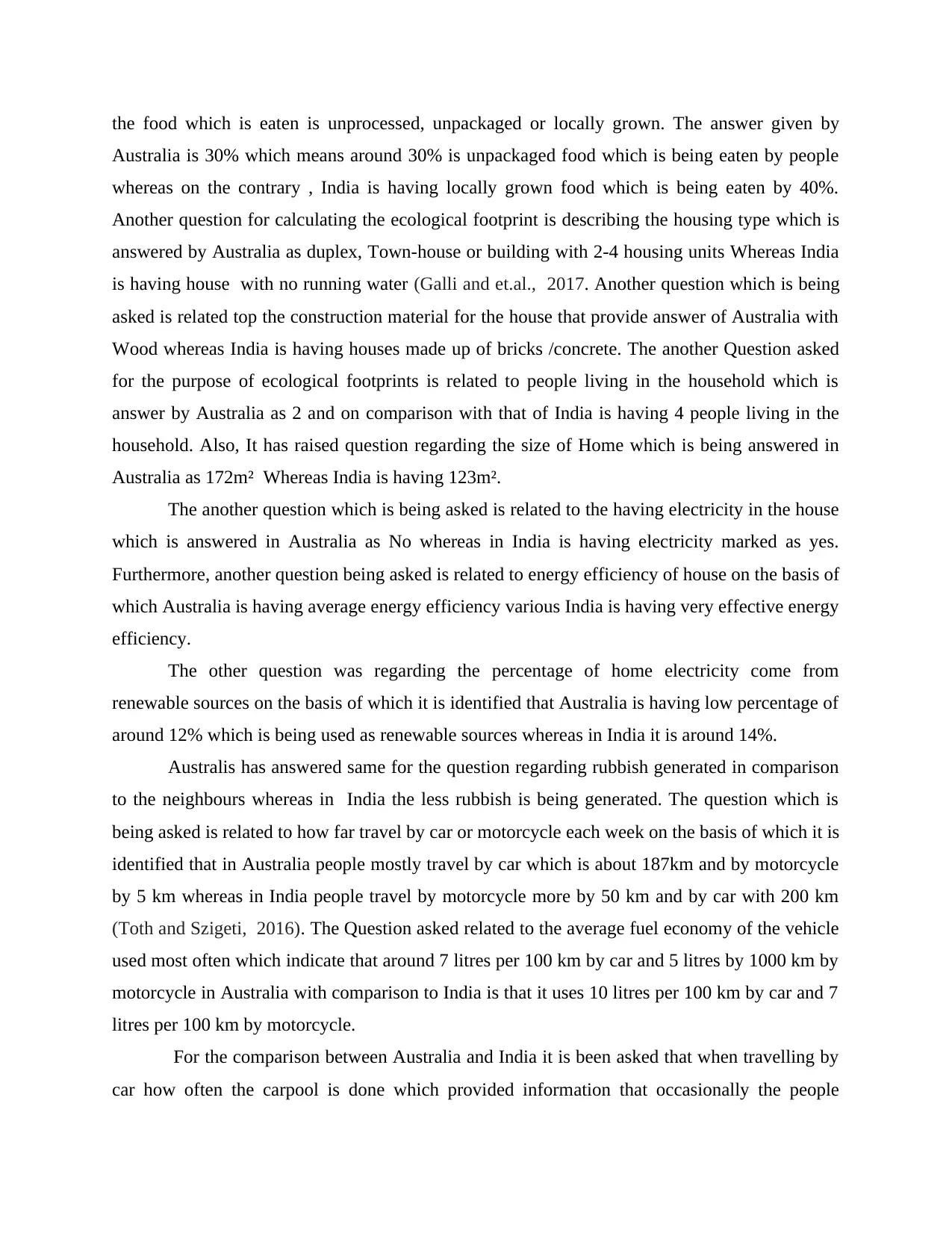
the food which is eaten is unprocessed, unpackaged or locally grown. The answer given by
Australia is 30% which means around 30% is unpackaged food which is being eaten by people
whereas on the contrary , India is having locally grown food which is being eaten by 40%.
Another question for calculating the ecological footprint is describing the housing type which is
answered by Australia as duplex, Town-house or building with 2-4 housing units Whereas India
is having house with no running water (Galli and et.al., 2017. Another question which is being
asked is related top the construction material for the house that provide answer of Australia with
Wood whereas India is having houses made up of bricks /concrete. The another Question asked
for the purpose of ecological footprints is related to people living in the household which is
answer by Australia as 2 and on comparison with that of India is having 4 people living in the
household. Also, It has raised question regarding the size of Home which is being answered in
Australia as 172m² Whereas India is having 123m².
The another question which is being asked is related to the having electricity in the house
which is answered in Australia as No whereas in India is having electricity marked as yes.
Furthermore, another question being asked is related to energy efficiency of house on the basis of
which Australia is having average energy efficiency various India is having very effective energy
efficiency.
The other question was regarding the percentage of home electricity come from
renewable sources on the basis of which it is identified that Australia is having low percentage of
around 12% which is being used as renewable sources whereas in India it is around 14%.
Australis has answered same for the question regarding rubbish generated in comparison
to the neighbours whereas in India the less rubbish is being generated. The question which is
being asked is related to how far travel by car or motorcycle each week on the basis of which it is
identified that in Australia people mostly travel by car which is about 187km and by motorcycle
by 5 km whereas in India people travel by motorcycle more by 50 km and by car with 200 km
(Toth and Szigeti, 2016). The Question asked related to the average fuel economy of the vehicle
used most often which indicate that around 7 litres per 100 km by car and 5 litres by 1000 km by
motorcycle in Australia with comparison to India is that it uses 10 litres per 100 km by car and 7
litres per 100 km by motorcycle.
For the comparison between Australia and India it is been asked that when travelling by
car how often the carpool is done which provided information that occasionally the people
Australia is 30% which means around 30% is unpackaged food which is being eaten by people
whereas on the contrary , India is having locally grown food which is being eaten by 40%.
Another question for calculating the ecological footprint is describing the housing type which is
answered by Australia as duplex, Town-house or building with 2-4 housing units Whereas India
is having house with no running water (Galli and et.al., 2017. Another question which is being
asked is related top the construction material for the house that provide answer of Australia with
Wood whereas India is having houses made up of bricks /concrete. The another Question asked
for the purpose of ecological footprints is related to people living in the household which is
answer by Australia as 2 and on comparison with that of India is having 4 people living in the
household. Also, It has raised question regarding the size of Home which is being answered in
Australia as 172m² Whereas India is having 123m².
The another question which is being asked is related to the having electricity in the house
which is answered in Australia as No whereas in India is having electricity marked as yes.
Furthermore, another question being asked is related to energy efficiency of house on the basis of
which Australia is having average energy efficiency various India is having very effective energy
efficiency.
The other question was regarding the percentage of home electricity come from
renewable sources on the basis of which it is identified that Australia is having low percentage of
around 12% which is being used as renewable sources whereas in India it is around 14%.
Australis has answered same for the question regarding rubbish generated in comparison
to the neighbours whereas in India the less rubbish is being generated. The question which is
being asked is related to how far travel by car or motorcycle each week on the basis of which it is
identified that in Australia people mostly travel by car which is about 187km and by motorcycle
by 5 km whereas in India people travel by motorcycle more by 50 km and by car with 200 km
(Toth and Szigeti, 2016). The Question asked related to the average fuel economy of the vehicle
used most often which indicate that around 7 litres per 100 km by car and 5 litres by 1000 km by
motorcycle in Australia with comparison to India is that it uses 10 litres per 100 km by car and 7
litres per 100 km by motorcycle.
For the comparison between Australia and India it is been asked that when travelling by
car how often the carpool is done which provided information that occasionally the people
⊘ This is a preview!⊘
Do you want full access?
Subscribe today to unlock all pages.

Trusted by 1+ million students worldwide
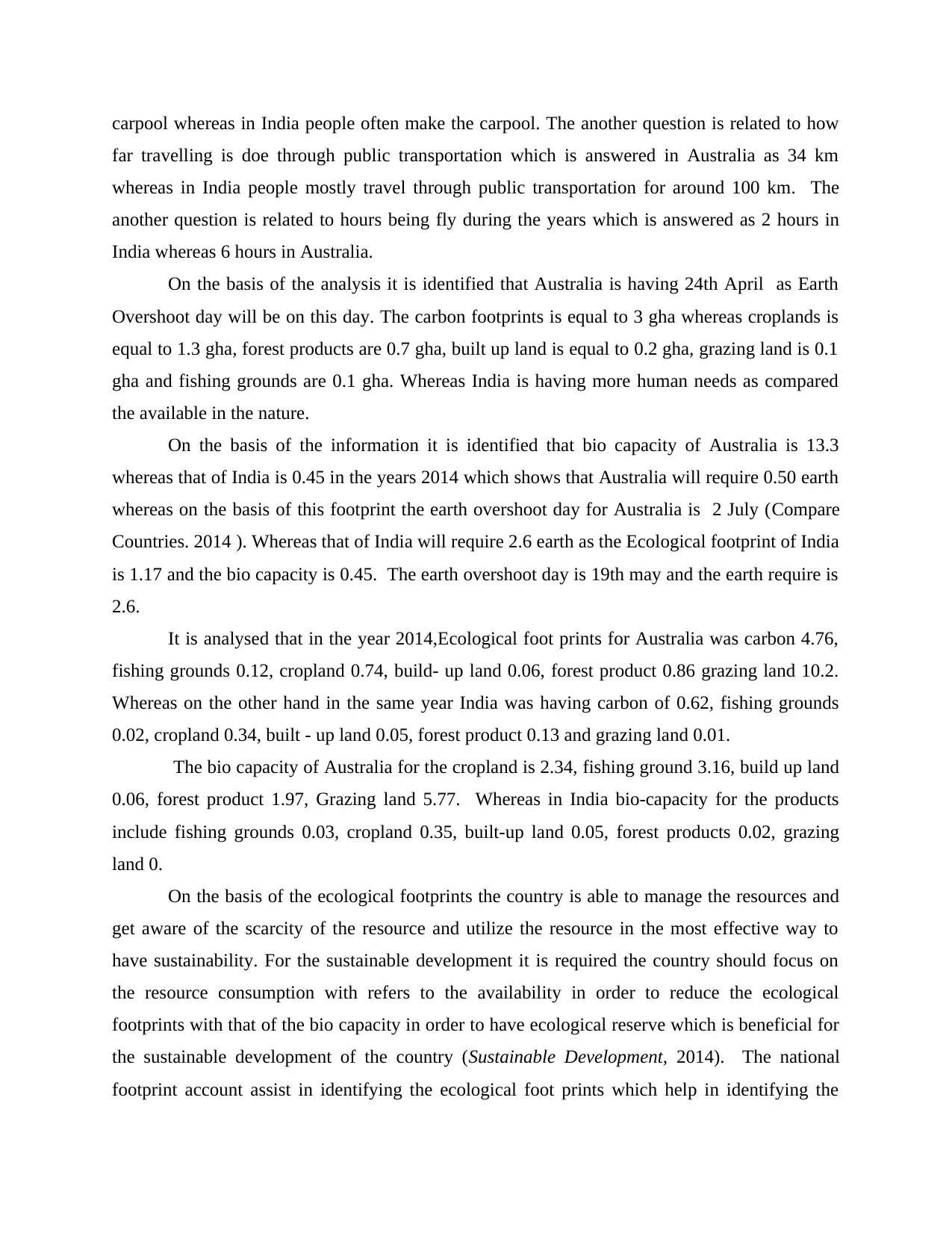
carpool whereas in India people often make the carpool. The another question is related to how
far travelling is doe through public transportation which is answered in Australia as 34 km
whereas in India people mostly travel through public transportation for around 100 km. The
another question is related to hours being fly during the years which is answered as 2 hours in
India whereas 6 hours in Australia.
On the basis of the analysis it is identified that Australia is having 24th April as Earth
Overshoot day will be on this day. The carbon footprints is equal to 3 gha whereas croplands is
equal to 1.3 gha, forest products are 0.7 gha, built up land is equal to 0.2 gha, grazing land is 0.1
gha and fishing grounds are 0.1 gha. Whereas India is having more human needs as compared
the available in the nature.
On the basis of the information it is identified that bio capacity of Australia is 13.3
whereas that of India is 0.45 in the years 2014 which shows that Australia will require 0.50 earth
whereas on the basis of this footprint the earth overshoot day for Australia is 2 July (Compare
Countries. 2014 ). Whereas that of India will require 2.6 earth as the Ecological footprint of India
is 1.17 and the bio capacity is 0.45. The earth overshoot day is 19th may and the earth require is
2.6.
It is analysed that in the year 2014,Ecological foot prints for Australia was carbon 4.76,
fishing grounds 0.12, cropland 0.74, build- up land 0.06, forest product 0.86 grazing land 10.2.
Whereas on the other hand in the same year India was having carbon of 0.62, fishing grounds
0.02, cropland 0.34, built - up land 0.05, forest product 0.13 and grazing land 0.01.
The bio capacity of Australia for the cropland is 2.34, fishing ground 3.16, build up land
0.06, forest product 1.97, Grazing land 5.77. Whereas in India bio-capacity for the products
include fishing grounds 0.03, cropland 0.35, built-up land 0.05, forest products 0.02, grazing
land 0.
On the basis of the ecological footprints the country is able to manage the resources and
get aware of the scarcity of the resource and utilize the resource in the most effective way to
have sustainability. For the sustainable development it is required the country should focus on
the resource consumption with refers to the availability in order to reduce the ecological
footprints with that of the bio capacity in order to have ecological reserve which is beneficial for
the sustainable development of the country (Sustainable Development, 2014). The national
footprint account assist in identifying the ecological foot prints which help in identifying the
far travelling is doe through public transportation which is answered in Australia as 34 km
whereas in India people mostly travel through public transportation for around 100 km. The
another question is related to hours being fly during the years which is answered as 2 hours in
India whereas 6 hours in Australia.
On the basis of the analysis it is identified that Australia is having 24th April as Earth
Overshoot day will be on this day. The carbon footprints is equal to 3 gha whereas croplands is
equal to 1.3 gha, forest products are 0.7 gha, built up land is equal to 0.2 gha, grazing land is 0.1
gha and fishing grounds are 0.1 gha. Whereas India is having more human needs as compared
the available in the nature.
On the basis of the information it is identified that bio capacity of Australia is 13.3
whereas that of India is 0.45 in the years 2014 which shows that Australia will require 0.50 earth
whereas on the basis of this footprint the earth overshoot day for Australia is 2 July (Compare
Countries. 2014 ). Whereas that of India will require 2.6 earth as the Ecological footprint of India
is 1.17 and the bio capacity is 0.45. The earth overshoot day is 19th may and the earth require is
2.6.
It is analysed that in the year 2014,Ecological foot prints for Australia was carbon 4.76,
fishing grounds 0.12, cropland 0.74, build- up land 0.06, forest product 0.86 grazing land 10.2.
Whereas on the other hand in the same year India was having carbon of 0.62, fishing grounds
0.02, cropland 0.34, built - up land 0.05, forest product 0.13 and grazing land 0.01.
The bio capacity of Australia for the cropland is 2.34, fishing ground 3.16, build up land
0.06, forest product 1.97, Grazing land 5.77. Whereas in India bio-capacity for the products
include fishing grounds 0.03, cropland 0.35, built-up land 0.05, forest products 0.02, grazing
land 0.
On the basis of the ecological footprints the country is able to manage the resources and
get aware of the scarcity of the resource and utilize the resource in the most effective way to
have sustainability. For the sustainable development it is required the country should focus on
the resource consumption with refers to the availability in order to reduce the ecological
footprints with that of the bio capacity in order to have ecological reserve which is beneficial for
the sustainable development of the country (Sustainable Development, 2014). The national
footprint account assist in identifying the ecological foot prints which help in identifying the
Paraphrase This Document
Need a fresh take? Get an instant paraphrase of this document with our AI Paraphraser
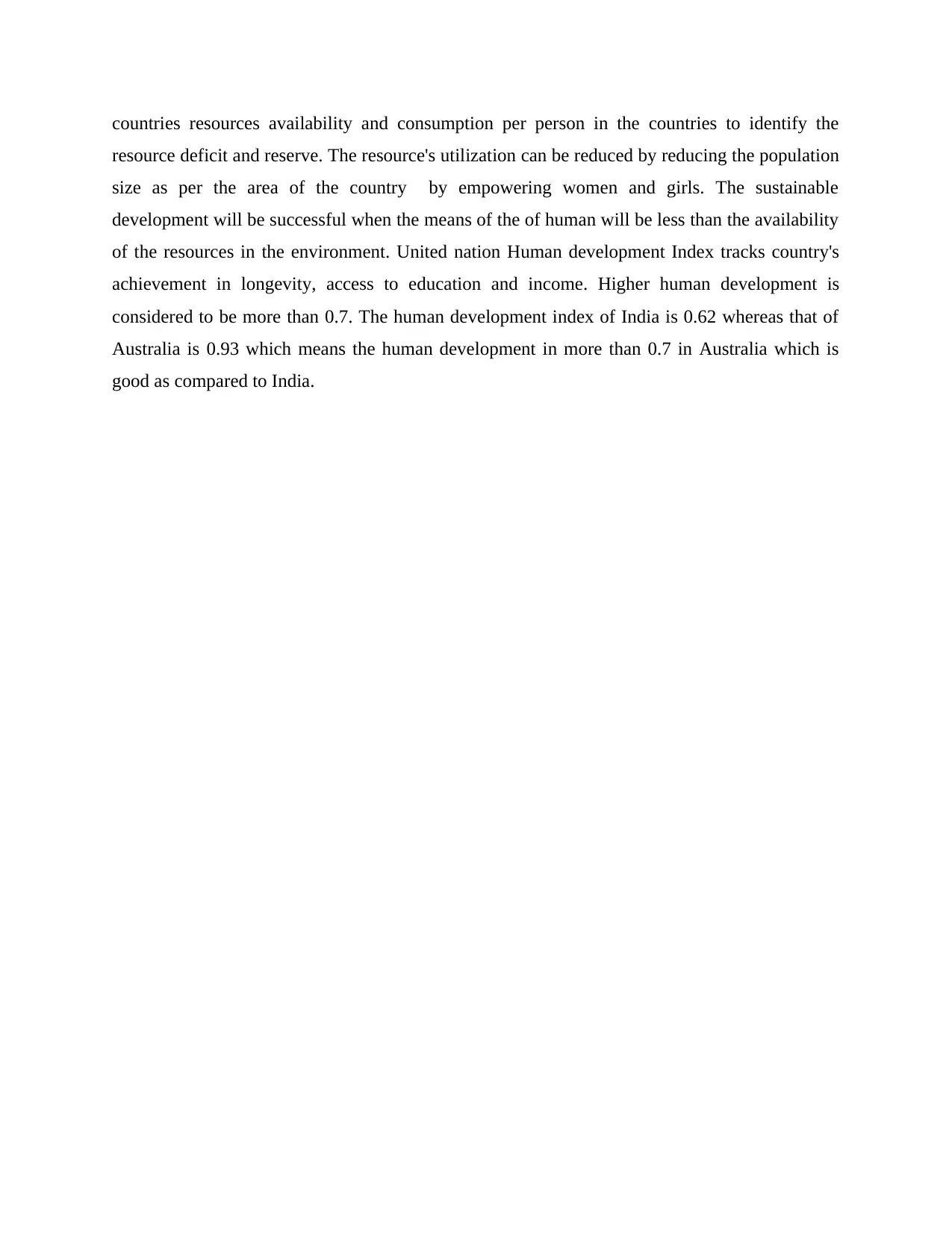
countries resources availability and consumption per person in the countries to identify the
resource deficit and reserve. The resource's utilization can be reduced by reducing the population
size as per the area of the country by empowering women and girls. The sustainable
development will be successful when the means of the of human will be less than the availability
of the resources in the environment. United nation Human development Index tracks country's
achievement in longevity, access to education and income. Higher human development is
considered to be more than 0.7. The human development index of India is 0.62 whereas that of
Australia is 0.93 which means the human development in more than 0.7 in Australia which is
good as compared to India.
resource deficit and reserve. The resource's utilization can be reduced by reducing the population
size as per the area of the country by empowering women and girls. The sustainable
development will be successful when the means of the of human will be less than the availability
of the resources in the environment. United nation Human development Index tracks country's
achievement in longevity, access to education and income. Higher human development is
considered to be more than 0.7. The human development index of India is 0.62 whereas that of
Australia is 0.93 which means the human development in more than 0.7 in Australia which is
good as compared to India.
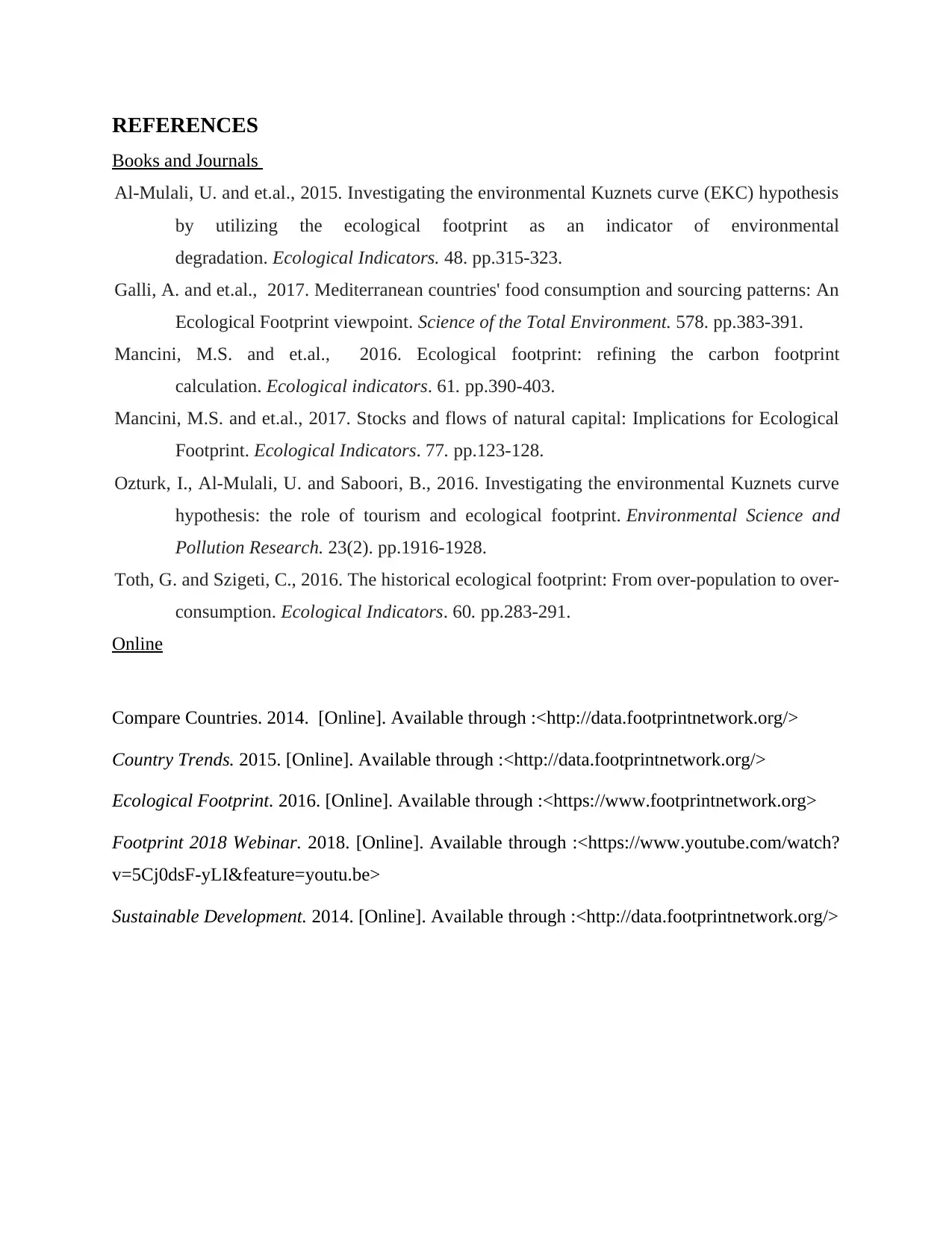
REFERENCES
Books and Journals
Al-Mulali, U. and et.al., 2015. Investigating the environmental Kuznets curve (EKC) hypothesis
by utilizing the ecological footprint as an indicator of environmental
degradation. Ecological Indicators. 48. pp.315-323.
Galli, A. and et.al., 2017. Mediterranean countries' food consumption and sourcing patterns: An
Ecological Footprint viewpoint. Science of the Total Environment. 578. pp.383-391.
Mancini, M.S. and et.al., 2016. Ecological footprint: refining the carbon footprint
calculation. Ecological indicators. 61. pp.390-403.
Mancini, M.S. and et.al., 2017. Stocks and flows of natural capital: Implications for Ecological
Footprint. Ecological Indicators. 77. pp.123-128.
Ozturk, I., Al-Mulali, U. and Saboori, B., 2016. Investigating the environmental Kuznets curve
hypothesis: the role of tourism and ecological footprint. Environmental Science and
Pollution Research. 23(2). pp.1916-1928.
Toth, G. and Szigeti, C., 2016. The historical ecological footprint: From over-population to over-
consumption. Ecological Indicators. 60. pp.283-291.
Online
Compare Countries. 2014. [Online]. Available through :<http://data.footprintnetwork.org/>
Country Trends. 2015. [Online]. Available through :<http://data.footprintnetwork.org/>
Ecological Footprint. 2016. [Online]. Available through :<https://www.footprintnetwork.org>
Footprint 2018 Webinar. 2018. [Online]. Available through :<https://www.youtube.com/watch?
v=5Cj0dsF-yLI&feature=youtu.be>
Sustainable Development. 2014. [Online]. Available through :<http://data.footprintnetwork.org/>
Books and Journals
Al-Mulali, U. and et.al., 2015. Investigating the environmental Kuznets curve (EKC) hypothesis
by utilizing the ecological footprint as an indicator of environmental
degradation. Ecological Indicators. 48. pp.315-323.
Galli, A. and et.al., 2017. Mediterranean countries' food consumption and sourcing patterns: An
Ecological Footprint viewpoint. Science of the Total Environment. 578. pp.383-391.
Mancini, M.S. and et.al., 2016. Ecological footprint: refining the carbon footprint
calculation. Ecological indicators. 61. pp.390-403.
Mancini, M.S. and et.al., 2017. Stocks and flows of natural capital: Implications for Ecological
Footprint. Ecological Indicators. 77. pp.123-128.
Ozturk, I., Al-Mulali, U. and Saboori, B., 2016. Investigating the environmental Kuznets curve
hypothesis: the role of tourism and ecological footprint. Environmental Science and
Pollution Research. 23(2). pp.1916-1928.
Toth, G. and Szigeti, C., 2016. The historical ecological footprint: From over-population to over-
consumption. Ecological Indicators. 60. pp.283-291.
Online
Compare Countries. 2014. [Online]. Available through :<http://data.footprintnetwork.org/>
Country Trends. 2015. [Online]. Available through :<http://data.footprintnetwork.org/>
Ecological Footprint. 2016. [Online]. Available through :<https://www.footprintnetwork.org>
Footprint 2018 Webinar. 2018. [Online]. Available through :<https://www.youtube.com/watch?
v=5Cj0dsF-yLI&feature=youtu.be>
Sustainable Development. 2014. [Online]. Available through :<http://data.footprintnetwork.org/>
⊘ This is a preview!⊘
Do you want full access?
Subscribe today to unlock all pages.

Trusted by 1+ million students worldwide
1 out of 9
Related Documents
Your All-in-One AI-Powered Toolkit for Academic Success.
+13062052269
info@desklib.com
Available 24*7 on WhatsApp / Email
![[object Object]](/_next/static/media/star-bottom.7253800d.svg)
Unlock your academic potential
Copyright © 2020–2025 A2Z Services. All Rights Reserved. Developed and managed by ZUCOL.





